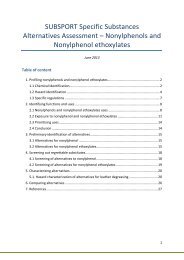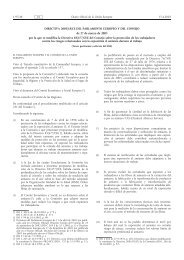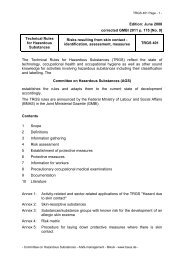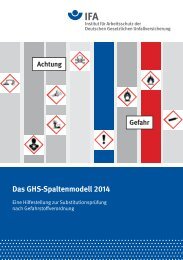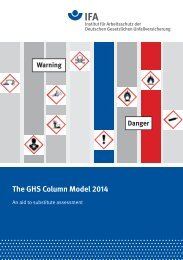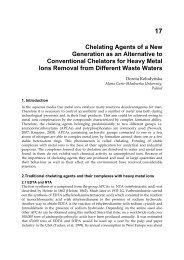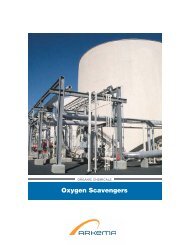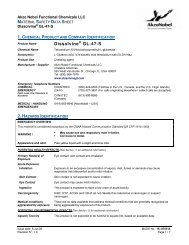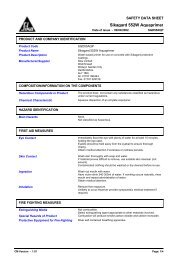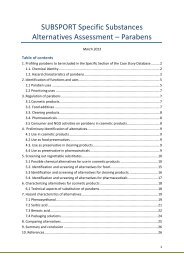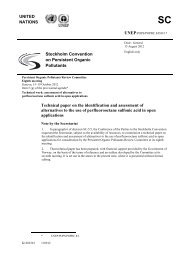Dissolvine® GL Technical brochure - AkzoNobel
Dissolvine® GL Technical brochure - AkzoNobel
Dissolvine® GL Technical brochure - AkzoNobel
Create successful ePaper yourself
Turn your PDF publications into a flip-book with our unique Google optimized e-Paper software.
Dissolvine ® <strong>GL</strong> <strong>Technical</strong> Brochure 13<br />
When only comparing readily biodegradable chelates for the removal of<br />
various stains, it was found that <strong>GL</strong>DA scores slightly better in household<br />
automatic dishwashing than the alternative products on a weight basis.<br />
The formulations had a neutral pH and contained 5wt% sequestrant. The<br />
result is given in Figure 12.<br />
Figure 13: The influence of <strong>GL</strong>DA on Bronopol. The chequered areas indicate<br />
conditions with germ growth, whereas the solid bars represent conditions with<br />
germ reduction.<br />
Figure 12: Stain removal performance of <strong>GL</strong>DA compared to alternative biodegradable<br />
sequestrants. (From WO2007/052064)<br />
Enhancing the effect of preservatives<br />
Chelates are often added to personal care products to improve shelf<br />
life. They are used, for example, to prevent rancidity occurring in fatty<br />
products by complexing trace amounts of metals, to complex hard water<br />
ions, or to boost the effect of other ingredients such as preservatives. All<br />
Dissolvine ® <strong>GL</strong> products are fully compliant with the European Cosmetics<br />
Directive and its amendments and adaptations (latest update 16 April<br />
2009) including the 7th amendment.<br />
Enhancing the effect of biocides<br />
Dissolvine ® <strong>GL</strong> is particularly suited for this application as it is more<br />
effective than EDTA when measured by the European standard 1276 (June<br />
1997) test for bactericidal activity. As a formulation it meets the criteria<br />
for designation as a green label. The criterion to pass the test is a Log 5<br />
reduction in bacterial activity within 5 minutes. The results for the gram<br />
negative bacteria Pseudomonas aeruginosa in a hard water environment<br />
(17°dH) are presented in Figure 14. By comparison, a smaller quantity of<br />
<strong>GL</strong>DA is required to obtain the equivalent biocidal activity.<br />
Similar positive effects on <strong>GL</strong>DA on the activity of biocides against<br />
gram negative bacteria, gram positive bacteria and fungi are described<br />
in patent number EP0683978. Chelates appear to remove calcium<br />
and magnesium ions present in the membrane of the bacterial cells,<br />
thereby increasing the permeability of the membrane to biocides. One<br />
unexpected effect is <strong>GL</strong>DA's greater ability to provide a boost compared<br />
to NTA or EDTA.<br />
The results of the challenge test are illustrated in Figure 13 using Bronopol<br />
as preservative. The results of all the experiments are summarized in<br />
Table 7. Dissolvine ® <strong>GL</strong> has no biocidal properties, but it can boost the<br />
effectiveness of preservatives and in doing so reduce the amount of<br />
preservative needed to achieve the desired effect. This ability to boost<br />
has been proven in gram negative bacteria, positive bacteria and mold,<br />
and for a variety of preservatives.<br />
Figure 14: The influence of EDTA and <strong>GL</strong>DA on the biocidal activity of<br />
Arquad ® MCB-50 against Pseudomonas aeruginosa.




